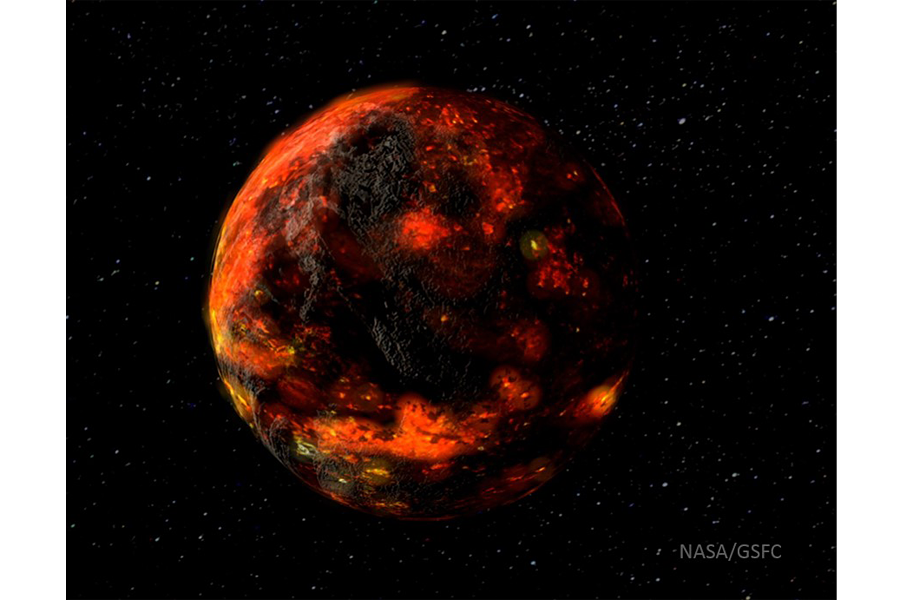Water on the moon? Asteroids, not comets, brought it.
Loading...
The moon might seem to be a dry husk orbiting our planet, but it's not that simple: Tiny water molecules are locked up in the lunar interior.
But how did they get there?
Ice-bearing asteroids that slammed into the newly formed satellite about 4.5 billion to 4.3 billion years ago could have deposited more than 80 percent of the moon's water, according to a model described Tuesday in the journal Nature Communications.
Wait, asteroids? Not comets? Comets are famously ice-rich bodies that stream through space, so some scientists thought these space snowballs delivered the moon's water.
"The easiest one to think of was cometary because it fit right in there," says Lawrence Taylor, a petrologist and geochemist at the University of Tennessee Knoxville, who was a co-author on a 2011 paper that pointed to comets as the source of water in the moon.
Not so, says a research team led by Jessica Barnes, a postdoctoral researcher at The Open University in Milton Keynes, England, who compared the chemical and isotopic composition of moon rocks with comets and asteroids that have slammed into Earth.
"The main source of the moon's water in the interior appears to be asteroids," says study co-author David Kring, senior scientist in the Center for Lunar Science and Exploration at the Lunar and Planetary Institute in Houston.
"Before we were saying, it's a comet, it's an asteroid, it's this, it's that," Dr. Taylor, who was not part of the new study, tells The Christian Science Monitor. But this new team is giving more evidence for their assertion of what brought water to the moon, he says. "I think they've made a lot of progress."
"The isotopic signature of hydrogen, for example, in asteroids is vastly different than that in comets," Dr. Kring tells the Monitor. "And the signature that one measures in the lunar sample is comparable to what we measure in asteroids as opposed to comets."
"At some level that makes perfect sense," Kring muses. "The asteroid belt is closer to the Earth and the moon than comets, so it's a more proximal source of material."
And although comets are at least half icy, many asteroids carry enough water locked up in clay minerals to have deposited it on the moon, too.
Looking at the moon today, it might be hard to imagine how a much smaller space rock could have deposited water molecules deep inside the moon. But 4.5 billion years ago the moon was more like a "molten blob in space," Kring says.
"We actually refer to this period as the lunar magma ocean," Kring explains. The moon was very hot at the time, so the mantle was molten. That magma formed a sort of ocean on the surface of the moon. Space rocks hitting the moon would have sunk in and been incorporated into this hot mushy rock.
About 4 billion years ago that magma ocean cooled and a crust formed over the moon, sealing off the interior from the rest of space. Any subsequent bombardment would have left craters on the surface of the moon, but wouldn't have had as much influence over the composition of the interior.
But, according to the model described by Dr. Barnes, Kring, and colleagues, enough space rocks managed to penetrate the magma ocean and deliver water and other volatiles deep into the moon before that cool crust sealed off the interior.
There's water on the surface of the moon, too, but scientists estimate that there's 10,000 to 10 million times more water in the interior. And the water inside the moon is enough to fill between 4 billion and 4 trillion Olympic-sized swimming pools, Kring estimates.
Understanding the origins of the water in the lunar interior could help scientists better understand the water on the surface of the moon, too. Perhaps that water originated deep within the moon and was deposited on the surface by volcanic eruptions, Kring says. Or perhaps it was dropped off by asteroids once the crust sealed off the interior, or other later surface processes.
Future exploration could help connect the dots of these "enigmatic deposits of water on the lunar surface" and determine if it comes from the same source as the water in the interior of the moon, Kring says.
Furthermore, "By understanding that asteroids are the main source of this water we are able to add to our picture of the collisional evolution of the solar system," Kring says.
"There are still some uncertainties of how often asteroids and comets penetrated the inner solar system" and how abundant those space objects were in the inner solar system at various times, he says. "And those types of objects can have a dramatic effect on planetary evolution."
For instance, "whatever was hitting the moon was also hitting the Earth," Kring says. If that period of time was characterized by water-carrying asteroids whizzing into the young Earth-moon system, it could help fill out the picture of water on early Earth, too.
This paper "has something that we've needed for a while," Taylor says. "And that's some kind of quantitative estimate on where the different sources of water have come from within the moon."
"They have put themselves out on a limb, to some extent," Taylor says. And hopefully that will stimulate further research, "it's something to shoot at now."
"I hope it's outrageous enough that people will start to look more closely at the approach that was taken," he says. "It will stimulate a refinement. You have to take your first step before you start to run, and I think this is a first step that is necessary."






